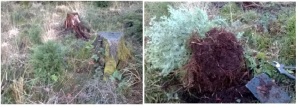Collecting trip for Wild Bonsai – New Years Eve 2013
Before reading anymore it is strongly recommended that everyone reads an excellent article by Walter Pall on the theory and ethics of collecting trees from the wild at:
http://www.bonsai4me.co.uk/AdvTech/ATcollectring%20trees%20from%20the%20wild%20W%20Pall.htm
The article focuses on collecting trees from the most inhospitable climates of the mountains. As we just don’t have the same quality of mountain as those Europeans it is quite possible for the enthusiast to find really good quality material much closer to home. Indeed this collecting trip was no more than 15 minutes from home! The key feature for me in looking for wild material is a combination of 3 factors – mature seed trees of the desired species, grazing and permission from the landowner.
Without the first of these there is just no point in combing the area as you will never find anything. Certain tree seeds can travel miles on the air but these generally do not produce high quality bonsai (Ash, Birch). Without the second the tree seedlings will race upwards producing tall thin whippy stems racing up for the light against all the competition, so a ‘normal’ woodland setting provides thousands of young trees but the search for good bonsai yamadori is usually fruitless.
So on New Year’s Eve 2013 I set out to a spot I have identified whilst walking the hills over the summer as being of good potential. There area in focus is about an acre of open ground surrounded by stands of tree species regularly seen as bonsai (Larch, Scots Pine, Beech and Western Hemlock), all throwing their seed. The area is occupied over the summer months by cattle, this acts to trample taller trees snapping out any potentially leggy trees, they also graze the tender young shoots giving a pruning far more regular than most bonsai enthusiasts can manage!
I was not disappointed with the find of many trampled chewed sorry looking specimens, who at this particular visit were also sat in deep puddles after all the recent rain. Many of the trees were decidedly not healthy, being sick and yellow, these were all left to their fate out in the wild. However some were a lush green despite the treatment, these got a closer look as they would have the strength to withstand uprooting
The first find was a Western Hemlock about 60cm tall, a quick investigation revealed a good root structure, and great nebari and taper. When testing with the spade it was clear that the roots were spread horizontally over a stony layer of soil about 10cm deep. This was a great bit of luck as it exactly what we would try to achieve in bonsai with the wide spreading roots in a relatively shallow pot. There was a good fibrous root system close to the trunk and not many thick roots.
The tree was bundled up securely to keep a good quantity of forest soil. This serves 2 purposes, the first is that keeping this soil intact after severing so many roots will give the tree the greatest chances. Secondly the soil is perfect for this tree to grow in (any doubts check out the 30m tall specimens not that far away, it will also contain mychorrhyzal fungal associations that will act as additional roots for the tree. A lot has been said about these beneficial fungi but many people assume that there is only one type and that all they need to do is give a tree a dose of spores and then sit back – job done. Few realise that there are thousands of different strains of fungi, some that would be perfect with one tree will be totally incompatible with another species, therefore the only way to be certain is to take some soil from the wild and mix in with the new soil
On returning home it was potted up in a generously sized pot to allow the roots as much room as possible to recover. In order to balance the reduction on root I also pruned the branches to maintain the correct root branch ratio and take some stress off the roots. This also begins the development of the tree’s structure and you can see the informal upright shape and the taper in these before and after photos. The final photo was taken 6 months later after a second prune and well ready for a final prune of the year to get it ready for the winter – clearly a healthy tree!




